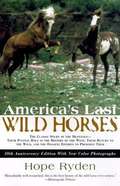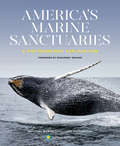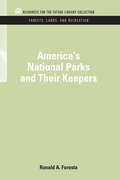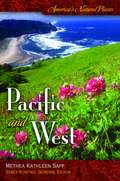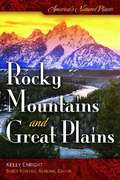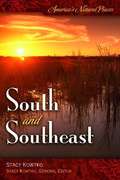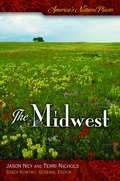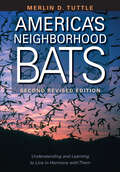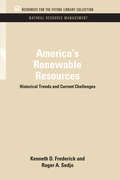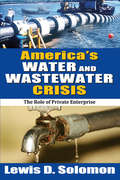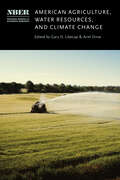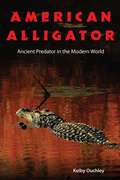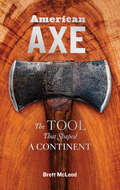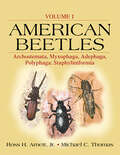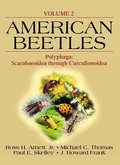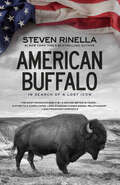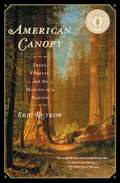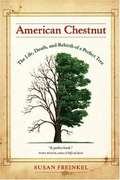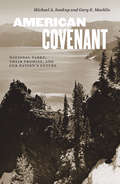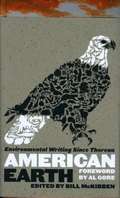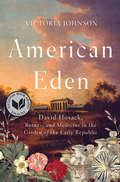- Table View
- List View
America's Last Wild Horses
by Hope RydenFrom the Book Jacket: "A richly researched and written book with an unusual appeal." -Publishers Weekly "This book is a treat for everyone who knows or cares about horses." -Cleveland Amory No wild animal captures the spirit of North America quite so powerfully as the wild horse-nor has any faced such diverse and potent enemies. In this provocative account, Hope Ryden-who helped to ensure the passage of the Wild and Free-Roaming Horse and Burro Act, which grants mustangs special protection-combs the history of these proud and noble horses; Descended from the Spanish horses ridden by the conquistadors, they evolved into the tough and intelligent ponies that Indians-and later, explorers and cowboys-learned to rely on. From the period when wholesale extermination of the buffalo was underway until recent times, commercial and political interests have sought to eliminate the wild horses as varmints. In the latest update to this classic story Ryden tells of the successes: and failures in the past ten years of regulation, and has added stunning new color photographs. The subject of a front-page article in The New York Times. when it was first published, america's last wild horses continues to be a compelling testament to the life of a uniquely American symbol of grace and wildness, and is a must read for horse lovers and Western history enthusiast everywhere.
America's Marine Sanctuaries: A Photographic Exploration
by NAT'L MARINE SANCTUARY FDNAn extraordinary illustrated overview of the National Marine Sanctuary System and a guide to its fourteen protected underwater locationsAmerica's Marine Sanctuaries tells the story of fourteen underwater places so important they are under special protection, together forming the US National Marine Sanctuary System. These sanctuaries, spanning more than 620,000 square miles and ranging from the Florida Keys to the Great Lakes and to the Hawaiian Islands, are critical and breathtaking marine habitats that provide homes to endangered and threatened species. They also preserve America's rich maritime heritage and act as living laboratories for science, research, education, and conservation, offering outdoor recreation experiences for all ages. Through 175 full-color photographs and lively narrative, America's Marine Sanctuaries showcases each of the marine sanctuaries and the creatures that live there, from whales and manatees to Hawaiian monk seals and Laysan ducks, as well as sunken ships from the Ghost Fleet and USS Monitor to Shipwreck Alley. The book underscores how marine sanctuaries have shaped the nation's development, survival, and identity, and celebrates these protected underwater treasures for all they can tell us about our communities, our country, and our world.
America's National Parks and Their Keepers (RFF Forests, Lands, and Recreation Set)
by Ronald A. ForestaFirst Published in 2011. Routledge is an imprint of Taylor & Francis, an informa company.
America's Natural Places: Pacific And West
by Methea K. SappFrom Alaska As Arctic National Wildlife Refuge to the Milnes and Prairie Preserve of New Mexico, this volume provides a snapshot of the most spectacular and important natural places in the western United States.
America's Natural Places: Rocky Mountains And Great Plains
by Kelly EnrightFrom Rocky Mountain National Park in Colorado to the Tallgrass Prairie National Preserve in Kansas, this volume provides a snapshot of the most spectacular and important natural places in the Great Plains and Rocky Mountains.
America's Natural Places: South And Southeast
by Stacy S. KowtkoFrom the Texas Blackland Prairies to the Middle Atlantic Coastal Plain of the Carolinas, this volume provides a snapshot of the most spectacular and important natural places in the southern United States.
America's Natural Places: The Midwest
by Jason Ney Terri NicholsFrom Iowa's Decorah Ice Cave to the Kitty Todd Nature Preserve in Ohio, this volume provides a snapshot of the most spectacular and important natural places in the Midwestern United States.
America's Neighborhood Bats: Understanding and Learning to Live in Harmony with Them (Revised Edition)
by Merlin D. TuttleA guide to these frequently misunderstood animals that dispels unnecessary fears and encourages an appreciation of bats and their conservation needs. Since its publication in 1988, America&’s Neighborhood Bats has changed the way we look at bats by underscoring their harmless and beneficial nature. In this revised edition, Merlin Tuttle offers bat aficionados the most up-to-date bat facts, including a wealth of new information on attracting bats and building bat houses and a revamped key to the identification of common North American species. The easy-to-understand text, clear illustrations, and spectacular color photographs make this the perfect bat book for the general reader, as well as an invaluable resource for professionals who field questions from the public. Those who provide advice at health and animal control departments, museums, zoos, and nature centers will find it especially useful.
America's Renewable Resources: Historical Trends and Current Challenges (RFF Natural Resource Management Set)
by Roger A. Sedjo Kenneth D. FrederickBy recording one country's experience with its vast natural resource base, America's Renewable Resources: Historical Trends and Current Challenges will help to inform the management of future demands on the resource base in the U.S. and throughout the world. The contributors focus specifically on renewable resources--water, forests, rangeland, cropland and soils, and wildlife--which possess the capacity to restore themselves after they have be consumed. Because this capacity can be destroyed and the time required for restoration can be very long, a balance in their use is necessary to sustain continued productivity. In arresting fashion, the authors trace the history of each resource's use from early colonial times through periods of dramatic, sometimes cataclysmic, changes in its utilization by an expanding, diversifying society. They show how unforeseen consequences have forced social institutions into existence and compelled policy makers, especially at the federal level, to deal with problems for which they were largely unprepared. America's Renewable Resources, by examining changes in demand, technologies, policies, and institutions, will assist both policy makers and the public at large to look past short-term events to the conditions fundamental to maintaining our future economic and environmental wellbeing. Originally published in 1991
America's Water and Wastewater Crisis: The Role of Private Enterprise
by Lewis D. SolomonThis book examines the role of private firms in the American water and wastewater industry. As more water infrastructure shifts from public- to private-sector control, vendors, consultants, and facilities are taking on more importance. Lewis D. Solomon presents an historical overview of water supply and treatment needs and the role of the government, including how water policy has been crafted. He argues that water scarcity is becoming a problem due to groundwater depletion, contamination, and patterns of consumption. He examines the impact of climate change on water availability and quality considering voluntary conservation programs and mandatory restrictions for water use.Solomon points to how for-profit firms can use technology to increase water supply. He describes what privatization would look like in practice and reviews evidence from two case studies. Solomon proposes privatization as a viable response to America's water crisis that can address both scarcity and capital problems.America's Water and Wastewater Crisis presents a careful examination of how the water industry has operated in the United States in the past and how it may work as we move into the future. This book is invaluable to environmental specialists, businessmen, and government officials.
America: The Farewell Tour
by Chris HedgesA profound and provocative examination of America in crisis, where unemployment, deindustrialization, and a bitter hopelessness and malaise have resulted in an epidemic of diseases of despair—drug abuse, gambling, suicide, magical thinking, xenophobia, and a culture of sadism and hate.America, says Pulitzer Prize–winning reporter Chris Hedges, is convulsed by an array of pathologies that have arisen out of profound hopelessness, a bitter despair and a civil society that has ceased to function. The opioid crisis, the retreat into gambling to cope with economic distress, the pornification of culture, the rise of magical thinking, the celebration of sadism, hate, and plagues of suicides are the physical manifestations of a society that is being ravaged by corporate pillage and a failed democracy. As our society unravels, we also face global upheaval caused by catastrophic climate change. All these ills presage a frightening reconfiguration of the nation and the planet. Donald Trump rode this disenchantment to power. In America: The Farewell Tour, Hedges argues that neither political party, now captured by corporate power, addresses the systemic problem. Until our corporate coup d’état is reversed these diseases will grow and ravage the country. A poignant cry reported from communities across the country, America: The Farewell Tour seeks to jolt us out of our complacency while there is still time.
American Agriculture, Water Resources, and Climate Change (National Bureau of Economic Research Conference Report)
by Gary D. Libecap and and Ariel DinarA collection of the most advanced and authoritative agricultural-economic research in the face of increasing water scarcity. Agriculture has been critical in the development of the American economy. Except in parts of the western United States, water access has not been a critical constraint on agricultural productivity, but with climate change, this may no longer be the case. This volume highlights new research on the interconnections between American agriculture, water resources, and climate change. It examines climatic and geologic factors that affect the agricultural sector and highlights historical and contemporary farmer responses to varying conditions and water availability. It identifies the potential effects of climate change on water supplies, access, agricultural practices, and profitability, and analyzes technological, agronomic, management, and institutional adjustments. Adaptations such as new crops, production practices, irrigation technologies, water conveyance infrastructure, fertilizer application, and increased use of groundwater can generate both social benefits and social costs, which may be internalized with various institutional innovations. Drawing on both historical and present experiences, this volume provides valuable insights into the economics of water supply in American agriculture as climate change unfolds.
American Alligator: Ancient Predator in the Modern World
by Kelby OuchleyHaving survived since the Mesozoic era, alligators teetered on the brink of extinction in the 1960s. Their recovery in the 1970s was largely due to legislative intervention, and today populations are closely monitored throughout their range. American Alligator is the most up-to-date and comprehensive treatment of this resilient relic, a creature with a brain weighing less than half an ounce that has successfully adapted to a changing Earth for more than 200 million years.Kelby Ouchley chronicles the evolution of A. mississippiensis from "shieldcroc"--the last common ancestor of modern-day alligators, crocodiles, caimans, and gavials--to its current role as keystone of the ecological health of America's southern swamps and marshes. In Florida, the apex predator uses its snout and feet to clear muck from holes in the limestone bedrock. During the dry season, these small ponds or "alligator holes" provide refuge, food, and water for a variety of wildlife. In Louisiana, millions of dollars are spent on the bounty of the non-native nutria that overgraze marsh vegetation, but alligators prey on these coastal rodents free of charge.The loss of the American alligator would be a blow to biodiversity and an ecosystem disruption affecting all levels of the food chain. While the U.S. Fish and Wildlife Service removed it from the endangered species list in 1987 and today regulates the legal trade of the animal and its products, Ouchley cautions us not to forget the lessons learned: human activities, from urban development to energy production, can still threaten the future of the gator and its southern wetland habitat.
American Axe: The Tool That Shaped a Continent
by Brett McLeodFrom bronze axes of the Viking conquests to the American homesteader&’s felling axe, this is a tool that has shaped human history like few others. American Axe pays tribute to this iconic instrument of settlement and industry, with rich history, stunning photography, and profiles of the most collectible vintage axes such as The Woodslasher, Keen Cutter, and True Temper Perfect. Combining his experiences as a forester, axe collector, and former competitive lumberjack, author Brett McLeod conveys the allure of this deceptively simple woodcutting implement and celebrates the resurging interest in its story and use.
American Beetles, Volume I: Archostemata, Myxophaga, Adephaga, Polyphaga: Staphyliniformia
by Jr. Ross H. Arnett Michael C. ThomasA thorough update of Arnett's The Beetles of the United States, American Beetles, Volumes I and II cover the genera of beetles that occur in Alaska, Canada, and the contiguous United States. Built on the foundation of the original work and almost completely rewritten with contributions from more than 60 coleopterists, these volumes describe each fa
American Beetles, Volume II: Polyphaga: Scarabaeoidea through Curculionoidea
by J. Howard Frank Ross H. Arnett Michael C. Thomas Paul E. SkelleyExperts offer the most sweeping reference available on the subject of North American beetles. Their rigorous standards for the presentation of data create a concise, useful format that is consistent throughout the book. This is the resource of choice for quick, accurate, and easily accessible information.
American Buffalo: In Search of a Lost Icon
by Steven RinellaA hunt for the American buffalo—an adventurous, fascinating examination of an animal that has haunted the American imagination. In 2005, Steven Rinella won a lottery permit to hunt for a wild buffalo, or American bison, in the Alaskan wilderness. Despite the odds—there’s only a 2 percent chance of drawing the permit, and fewer than 20 percent of those hunters are successful—Rinella managed to kill a buffalo on a snow-covered mountainside and then raft the meat back to civilization while being trailed by grizzly bears and suffering from hypothermia. Throughout these adventures, Rinella found himself contemplating his own place among the 14,000 years’ worth of buffalo hunters in North America, as well as the buffalo’s place in the American experience. At the time of the Revolutionary War, North America was home to approximately 40 million buffalo, the largest herd of big mammals on the planet, but by the mid-1890s only a few hundred remained. Now that the buffalo is on the verge of a dramatic ecological recovery across the West, Americans are faced with the challenge of how, and if, we can dare to share our land with a beast that is the embodiment of the American wilderness. American Buffalois a narrative tale of Rinella’s hunt. But beyond that, it is the story of the many ways in which the buffalo has shaped our national identity. Rinella takes us across the continent in search of the buffalo’s past, present, and future: to the Bering Land Bridge, where scientists search for buffalo bones amid artifacts of the New World’s earliest human inhabitants; to buffalo jumps where Native Americans once ran buffalo over cliffs by the thousands; to the Detroit Carbon works, a “bone charcoal” plant that made fortunes in the late 1800s by turning millions of tons of buffalo bones into bone meal, black dye, and fine china; and even to an abattoir turned fashion mecca in Manhattan’s Meatpacking District, where a depressed buffalo named Black Diamond met his fate after serving as the model for the American nickel. Rinella’s erudition and exuberance, combined with his gift for storytelling, make him the perfect guide for a book that combines outdoor adventure with a quirky blend of facts and observations about history, biology, and the natural world. Both a captivating narrative and a book of environmental and historical significance,American Buffalotells us as much about ourselves as Americans as it does about the creature who perhaps best of all embodies the American ethos.
American Canopy: The Role of Trees in the Shaping of a Nation
by Eric RutkowThis fascinating and groundbreaking work tells the remarkable story of the relationship between Americans and their trees across the entire span of our nation's history. Like many of us, historians have long been guilty of taking trees for granted. Yet the history of trees in America is no less remarkable than the history of the United States itself--from the majestic white pines of New England, which were coveted by the British Crown for use as masts in navy warships, to the orange groves of California, which lured settlers west. In fact, without the country's vast forests and the hundreds of tree species they contained, there would have been no ships, docks, railroads, stockyards, wagons, barrels, furniture, newspapers, rifles, or firewood. No shingled villages or whaling vessels in New England. No New York City, Miami, or Chicago. No Johnny Appleseed, Paul Bunyan, or Daniel Boone. No Allied planes in World War I, and no suburban sprawl in the middle of the twentieth century. America--if indeed it existed--would be a very different place without its millions of acres of trees. As Eric Rutkow's brilliant, epic account shows, trees were essential to the early years of the republic and indivisible from the country's rise as both an empire and a civilization. Among American Canopy's many fascinating stories: the Liberty Trees, where colonists gathered to plot rebellion against the British; Henry David Thoreau's famous retreat into the woods; the creation of New York City's Central Park; the great fire of 1871 that killed a thousand people in the lumber town of Peshtigo, Wisconsin; the fevered attempts to save the American chestnut and the American elm from extinction; and the controversy over spotted owls and the old-growth forests they inhabited. Rutkow also explains how trees were of deep interest to such figures as George Washington, Thomas Jefferson, Benjamin Franklin, Teddy Roosevelt, and FDR, who oversaw the planting of more than three billion trees nationally in his time as president. As symbols of liberty, community, and civilization, trees are perhaps the loudest silent figures in our country's history. America started as a nation of people frightened of the deep, seemingly infinite woods; we then grew to rely on our forests for progress and profit; by the end of the twentieth century we came to understand that the globe's climate is dependent on the preservation of trees. Today, few people think about where timber comes from, but most of us share a sense that to destroy trees is to destroy part of ourselves and endanger the future. Never before has anyone treated our country's trees and forests as the subject of a broad historical study, and the result is an accessible, informative, and thoroughly entertaining read. Audacious in its four-hundred-year scope, authoritative in its detail, and elegant in its execution, American Canopy is perfect for history buffs and nature lovers alike and announces Eric Rutkow as a major new author of popular history.
American Canopy: Trees, Forests, and the Making of a Nation
by Eric RutkowThis fascinating and groundbreaking work tells the remarkable story of the relationship between Americans and their trees across the entire span of our nation's history. Like many of us, historians have long been guilty of taking trees for granted. Yet the history of trees in America is no less remarkable than the history of the United States itself--from the majestic white pines of New England, which were coveted by the British Crown for use as masts in navy warships, to the orange groves of California, which lured settlers west. In fact, without the country's vast forests and the hundreds of tree species they contained, there would have been no ships, docks, railroads, stockyards, wagons, barrels, furniture, newspapers, rifles, or firewood. No shingled villages or whaling vessels in New England. No New York City, Miami, or Chicago. No Johnny Appleseed, Paul Bunyan, or Daniel Boone. No Allied planes in World War I, and no suburban sprawl in the middle of the twentieth century. America--if indeed it existed--would be a very different place without its millions of acres of trees. As Eric Rutkow's brilliant, epic account shows, trees were essential to the early years of the republic and indivisible from the country's rise as both an empire and a civilization. Among American Canopy's many fascinating stories: the Liberty Trees, where colonists gathered to plot rebellion against the British; Henry David Thoreau's famous retreat into the woods; the creation of New York City's Central Park; the great fire of 1871 that killed a thousand people in the lumber town of Peshtigo, Wisconsin; the fevered attempts to save the American chestnut and the American elm from extinction; and the controversy over spotted owls and the old-growth forests they inhabited. Rutkow also explains how trees were of deep interest to such figures as George Washington, Thomas Jefferson, Benjamin Franklin, Teddy Roosevelt, and FDR, who oversaw the planting of more than three billion trees nationally in his time as president. As symbols of liberty, community, and civilization, trees are perhaps the loudest silent figures in our country's history. America started as a nation of people frightened of the deep, seemingly infinite woods; we then grew to rely on our forests for progress and profit; by the end of the twentieth century we came to understand that the globe's climate is dependent on the preservation of trees. Today, few people think about where timber comes from, but most of us share a sense that to destroy trees is to destroy part of ourselves and endanger the future. Never before has anyone treated our country's trees and forests as the subject of a broad historical study, and the result is an accessible, informative, and thoroughly entertaining read. Audacious in its four-hundred-year scope, authoritative in its detail, and elegant in its execution, American Canopy is perfect for history buffs and nature lovers alike and announces Eric Rutkow as a major new author of popular history.
American Chestnut: The Life, Death, and Rebirth of a Perfect Tree
by Susan FreinkelThe American chestnut was one of America's most common, valued, and beloved trees. Susan Freinkel tells the dramatic story of the stubborn optimists who refused to let this cultural icon go. In a compelling weave of history, science, and personal observation, she relates their quest to save the tree through methods that ranged from classical plant breeding to cutting-edge gene technology.
American Covenant: National Parks, Their Promise, and Our Nation's Future
by Gary E Machlis Michael A SoukupAn intimate and candid account of our national parks and their strengths, vulnerabilities, and essential role in American life Part memoir, part critique, and paean to the value of national parks, American Covenant distills the experience and insights from two long careers in conservation. Michael A. Soukup and Gary E. Machlis show how the national parks are essential to maintaining the essence of our national heritage, and key to America&’s future in a changing climate and political landscape. Sharing real-world examples of both victories and defeats in protecting national parks, this candid, thoughtful book reminds us that the national parks are a promise—a covenant—within and between generations of Americans. The book is also a call to revitalize, reconstitute, reconfigure, and reform the National Park Service, which the authors believe is governed too much by outdated management practices and politics instead of a foundation of expertise and science.
American Earth: Environmental Writing Since Thoreau
by Al Gore Bill MckibbenAs America and the world grapple with the consequences of global environmental change, writer and activist Bill McKibben offers this unprecedented, provocative, and timely anthology, gathering the best and most significant American environmental writing from the last two centuries. Classics of the environmental imagination'the essays of Henry David Thoreau, John Muir, and John Burroughs; Aldo Leopold's A Sand County Almanac; Rachel Carson's Silent Spring are set against the inspiring story of an emerging activist movement, as revealed by newly uncovered reports of pioneering campaigns for conservation, passages from landmark legal opinions and legislation, and searing protest speeches. Here are some of America's greatest and most impassioned writers, taking a turn toward nature and recognizing the fragility of our situation on earth and the urgency of the search for a sustainable way of life. Thought-provoking essays on overpopulation, consumerism, energy policy, and the nature of "nature" join ecologists' memoirs and intimate sketches of the habitats of endangered species. The anthology includes a detailed chronology of the environmental movement and American environmental history, as well as an 80-page color portfolio of illustrations.
American Eden: David Hosack, Botany, And Medicine In The Garden Of The Early Republic
by Victoria JohnsonThe untold story of Hamilton’s—and Burr’s—personal physician, whose dream to build America’s first botanical garden inspired the young Republic. <P><P>On a clear morning in July 1804, Alexander Hamilton stepped onto a boat at the edge of the Hudson River. He was bound for a New Jersey dueling ground to settle his bitter dispute with Aaron Burr. Hamilton took just two men with him: his “second” for the duel, and Dr. David Hosack. <P><P>As historian Victoria Johnson reveals in her groundbreaking biography, Hosack was one of the few points the duelists did agree on. Summoned that morning because of his role as the beloved Hamilton family doctor, he was also a close friend of Burr. A brilliant surgeon and a world-class botanist, Hosack—who until now has been lost in the fog of history—was a pioneering thinker who shaped a young nation. <P><P>Born in New York City, he was educated in Europe and returned to America inspired by his newfound knowledge. He assembled a plant collection so spectacular and diverse that it amazes botanists today, conducted some of the first pharmaceutical research in the United States, and introduced new surgeries to American. His tireless work championing public health and science earned him national fame and praise from the likes of Thomas Jefferson, James Madison, Alexander von Humboldt, and the Marquis de Lafayette. <P><P>One goal drove Hosack above all others: to build the Republic’s first botanical garden. Despite innumerable obstacles and near-constant resistance, Hosack triumphed when, by 1810, his Elgin Botanic Garden at last crowned twenty acres of Manhattan farmland. “Where others saw real estate and power, Hosack saw the landscape as a pharmacopoeia able to bring medicine into the modern age” (Eric W. Sanderson, author of Mannahatta). Today what remains of America’s first botanical garden lies in the heart of midtown, buried beneath Rockefeller Center. <P><P>Whether collecting specimens along the banks of the Hudson River, lecturing before a class of rapt medical students, or breaking the fever of a young Philip Hamilton, David Hosack was an American visionary who has been too long forgotten. Alongside other towering figures of the post-Revolutionary generation, he took the reins of a nation. In unearthing the dramatic story of his life, Johnson offers a lush depiction of the man who gave a new voice to the powers and perils of nature.
American Energy: The Politics of 21st Century Policy
by Walter A. RosenbaumThere are rapid, and sometimes radical, changes now transforming energy production and consumption in the United States. Utilizing contemporary examples throughout his narrative, Walter A. Rosenbaum captures this transformation in American Energy: The Politics of 21st Century Policy while analyzing how important actors, institutions, and issues impact American energy policymaking. With clear explanations of relevant energy technologies—from controversial fracking to mountain top mining to nuclear waste storage—the book first looks at the policy options available in governing the energy economy and then discusses specific resources (petroleum and natural gas, coal, nuclear power, electricity, renewable energy, conservation) and the global energy challenges associated with climate change. This is a perfect supplement for any environmental politics course.
American Energy: The Politics of 21st Century Policy
by Walter A. RosenbaumThere are rapid, and sometimes radical, changes now transforming energy production and consumption in the United States. Utilizing contemporary examples throughout his narrative, Walter A. Rosenbaum captures this transformation in American Energy: The Politics of 21st Century Policy while analyzing how important actors, institutions, and issues impact American energy policymaking. With clear explanations of relevant energy technologies—from controversial fracking to mountain top mining to nuclear waste storage—the book first looks at the policy options available in governing the energy economy and then discusses specific resources (petroleum and natural gas, coal, nuclear power, electricity, renewable energy, conservation) and the global energy challenges associated with climate change. This is a perfect supplement for any environmental politics course.
